The Kingdom of Bhutan, or Druk Yul, the “Land of the Thunder Dragon,” as the Bhutanese call it, is the subject of legends and rumors. And the best way to find out what is true and what is fiction is to visit the country yourself.
You can fly to Bhutan from Thailand, India, Singapore or Nepal. The airport in Paro is considered one of the most difficult in the world for takeoff and landing, as it is squeezed by mountains, and the runway is very short.

Until 1974, one could only get to Bhutan by personal invitation of the king or queen. Now it has become much easier, but an economic method is used to regulate the tourist flow: you need to pay a certain amount for your stay in the country to a licensed travel company. The package includes accommodation, food and guide services. Part of the cost (about $65 per day) is the royal tax, the proceeds of which are directed to the social needs of Bhutan: medicine, infrastructure development, and so on.
Our goal was to shoot landmarks from a drone, and we started preparing for the trip in advance. Until recently, the use of such devices was prohibited in the country. We were very happy when we learned that permission had been received.
The plane comes in for a steep landing; houses and trees on the mountain slopes flash past the window, and here we are in Paro, in mysterious Bhutan! The first flight near the dzong (as the fortress-monasteries are called) of Paro is planned for the next day.

We receive additional instructions from the aviation security service: do not fly too close, do not fly above the roof, do not fly at the same time as airplanes and helicopters – the airport is only one and a half kilometers away. The sun is shining, the wind is blowing clouds over the slopes of the Himalayas, the impregnable walls of the dzong rise. Stanislav launches the drone, and we start filming. Beautiful!
Five minutes later, the police arrive to ask what we are doing here. We show all the papers and permits; the aviation security inspector is also with us, he confirms that everything is in order. However, time passes, more police officers arrive, representatives of the aviation industry, and a quick solution to the issue is clearly not expected. In the end, we move with all our belongings to the civil aviation office, where it turns out that despite having all the necessary documents, there is an order that drones are not allowed to fly in Paro. Case law in action.
As a result, all existing permits are suspended and must be obtained again. Until then, they cannot be removed.
Our friends from White Umbrella Tours, who organized the trip, did the unthinkable, having received new approval from the necessary authorities in just a couple of days. We were happy, but too early: now an addendum appeared in the stack of documents, and in it - a list of places prohibited for flights, which included all the main monasteries, dzongs and large settlements... That is, all that was left was to photograph nature, which, frankly speaking, is almost no different from our North Caucasus.
It was still possible to film from the ground. But the video should not be closer than 200 meters from the dzongs. Checkmate! We had to completely rework the filming plan, removing all the dzongs from it.
While our guides were busy getting the papers, we made a trek to what is probably the most famous monastery in Bhutan – Taktsang Lhakhang, the “Tigress’s Nest”. According to legend, Guru Rinpoche flew here on the back of a tigress; hence the name. The monastery is clinging to a cliff at an altitude of 3,120 meters, and you have to climb up to it on foot along a mountain path. Without acclimatization, this is quite a difficult journey, but our guide Karma encourages us.
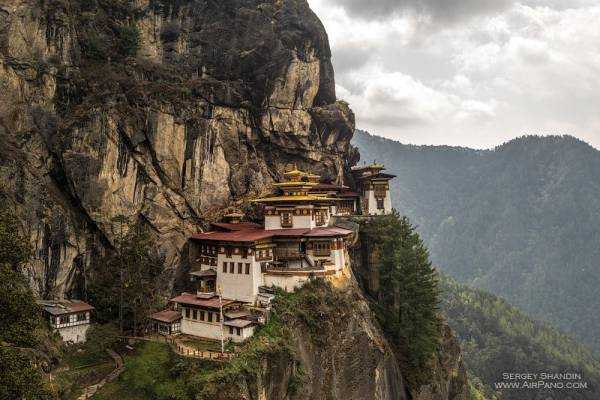
And so, after an hour and a half of climbing up the mountain, a view of the monastery opens up. We go through a thorough check at the entrance: you can’t take not only photographic equipment inside, but even phones. Having looked at the temples, we went down into the cave where Guru Rinpoche once meditated, and drank sacred water flowing from the rock. The way back seemed a little easier to us.
From Paro we went to the capital – Thimphu. There are quite a lot of cars in the city, but there is not a single traffic light; traffic controllers control traffic at intersections. The capital is home to the king’s residence. Thimphu Dzong is very beautiful, and in the evening its towers are illuminated with lights. Alas, we couldn’t film all this from the air either.
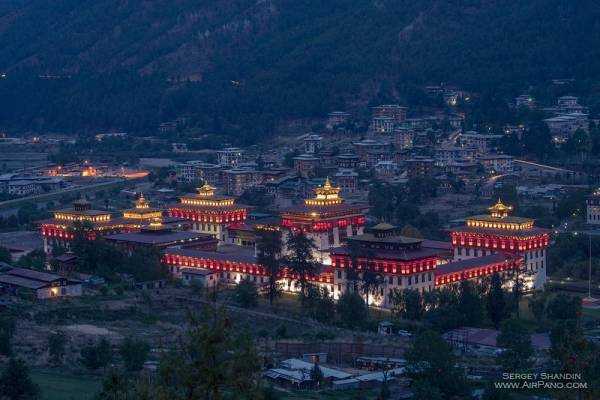
The next day we visited the Simtokha Dzong on the outskirts of Paro. This is the first dzong built by Shabdrung himself, the founder of Bhutan. We were lucky enough to meet a military man here. I don’t know much about the insignia of the Bhutanese army, but apparently he was a high-ranking officer. We got to talking, and he invited us to go with him and see what tourists are not shown. We called a monk, who opened for us the room in which Shabdrung’s father lived and died.
We also got to see the sacred royal crown kept in the monks' study room. Simthoka Dzong was besieged during the war with the Tibetans and was captured. The victors gathered in the central temple, but it collapsed on them and they died. It is said that this was the spirit protector of the place standing up for his own.
Finally, all the permits are obtained, and we drive further, into the country. The road is being repaired, the asphalt has been removed along its entire length, and the car barely drags itself along the dusty serpentine, passing herds of cows and oncoming trucks. The Dochu-la Pass at an altitude of 3,116 meters awaits us, where we will spend the night.
After the heat of Paro and Thimphu, the dawn on Dochu-la is very fresh. The sun breaks through the haze, illuminating the mountains and 108 stupas-chortens. Branches burn in the ritual incense stove. Stas launches the drone, and the shooting begins. In the morning light, the stupas on the top of the hill look magnificent.
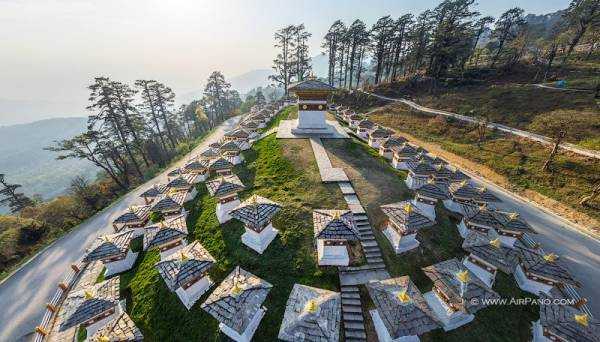
The next point of our plan was Punakha – a very beautiful dzong on the river bank, surrounded by flowering trees. It is also the winter residence of Je Khenpo, the head of the country's clergy. Royal relics are also kept here. Alas, Punakha Dzong is on the "black list": we can only take photos in the courtyard and video from the opposite bank.
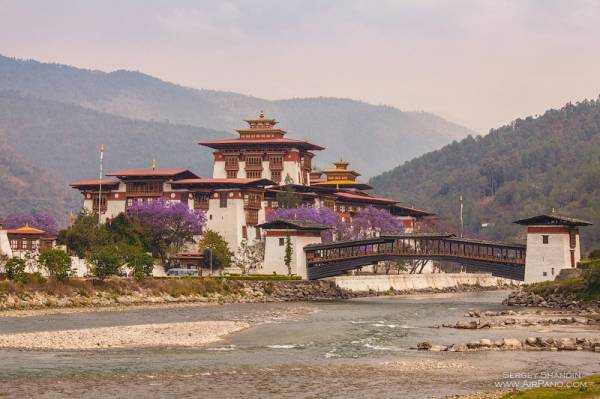
After sunset, we arrive in Gangtey, famous for its bird sanctuary. But we are more interested in the Gangtey Gompa monastery, and we set off for it in the morning. There we are introduced to the lama, and after negotiations we receive permission to launch a drone.
After filming, we visited the monastery itself and its main temple, and then we were invited to see something unusual. Following the monk, we climbed up a steep wooden staircase with narrow steps to the second floor. Our eyes got used to the semi-darkness a little, and we went into a small room.
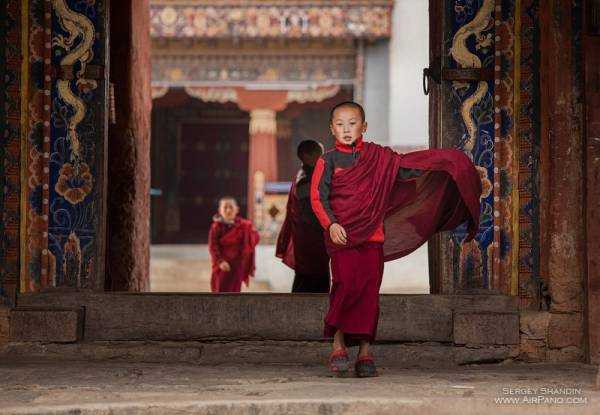
Along the wall there is an altar. On its sides there are figures of military leaders with dark, menacing faces. On their heads are iron hats. The fire in the lamps, filled with cow oil, dances, and sometimes it seems that the figures are moving. To the left of the altar there are weapons hanging on the wall: from ancient swords to a modern machine gun with a fixed bayonet. Some monsters are looking from the right wall. I come closer. And that's right: these are dried heads of different animals, tusks and horns. Here is the grinning head of a leopard, its skin has dried out, which is why its menacing fangs protrude even more. Here is the head of a buffalo, and next to it - a wild boar. Here you can see the beak of a hornbill. A giant fish hangs from the ceiling, similar to a catfish, but with huge sharp teeth. The monk explains that these are all defeated demons, collected as trophies.
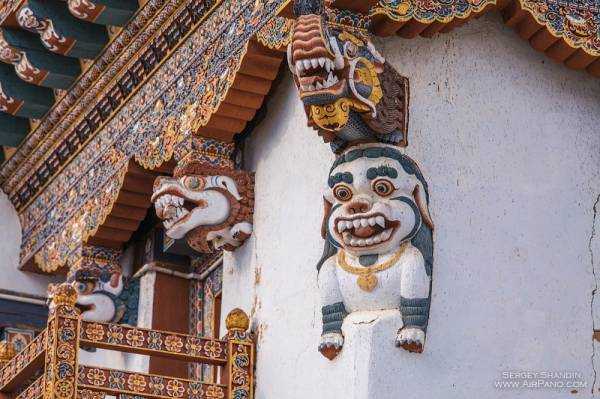
My gaze falls on something strange; I shudder… I wasn’t imagining it: it’s a human hand. On the wall, almost under the ceiling, to the left of the “trophies,” hangs a strange creature. At first I decided it was a monkey, but no, the skull with dried-out skin is completely human, although small. A long body, narrow palms and feet. The blackened skin stretched over the bones, but there was no decay, the facial features and hands were preserved. A small person, but not a child – the proportions were different. An eerie feeling, especially together with the rest of the bestiary. This is a tseluchup, a creature like a hobbit, as we were told. Also a demon.
I read something about tribes of dwarfs found in the Himalayas - they were mentioned by travelers in the 19th century. Perhaps this is one of their tribe, who unluckily fell into the hands of a lama who considered him a demon... Many secrets are kept behind the walls of ancient monasteries.
After Gangtey, we went to Bumthang province. This is a very beautiful area, also called the “Bhutanese Switzerland”. Here we visited the Thangbi Lhakhang monastery. The lama greeted us very warmly and allowed us to film the puja – a prayer ritual. In general, filming inside temples is usually not allowed, but here they made an exception for us.
We spent two days in the monastery. We attended religious ceremonies, drank tea, and in the evening played various games with the monks. For example, you have to lift and carry a stone weighing almost a hundred kilograms. If you carry it around, all your sins are reset. I managed only a quarter of the way around.
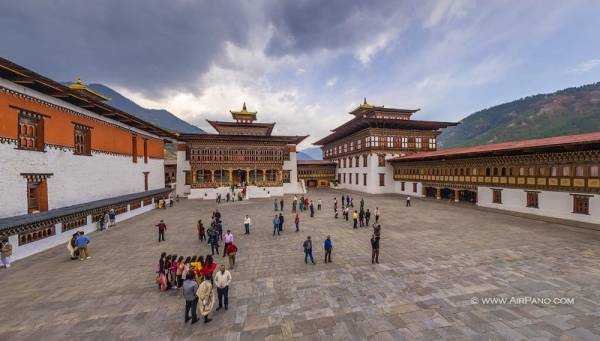
Bhutan is a very interesting and unique country; one can talk about it for a very long time. One of the most unusual differences from other countries is the legislatively enshrined desire for happiness. In 1972, King Jigme introduced the principle of Gross National Happiness: this priority here is higher than the Gross National Product, which is the basis of life in all other countries.
The country is now ruled by his son, Jigme Khesar Namgyel Wangchuck, who ascended the throne in 2006 at the age of 26, making him the youngest reigning monarch in the world. He has continued the tradition of valuing happiness over wealth.
Historical values – cultural and spiritual – influence the lives of modern Bhutanese. The country is proud of its forests, flora and fauna, so environmental protection is one of the most important points of the National Happiness Program. In addition, the road to national happiness includes education reform, compulsory English language teaching, construction of roads without damaging nature, care for the elderly, state guardianship of monasteries, a ban on smoking, a ban on chemical fertilizers, keeping the streets clean, growing flowers and much more.
We thank the company for helping us organize our trip. White Umbrella Tours, and personally Natalia and Tashi Wangdi, our guide Karma Yunten, driver Karma, as well as everyone who helped us and supported us.
Source: travel.ru
